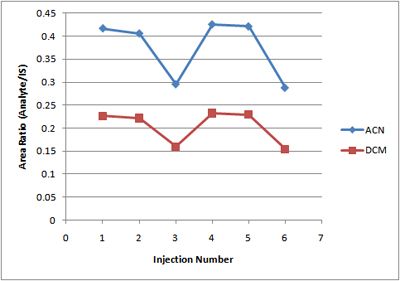Page 1 of 1
Reduction/gain of area counts in one analyte of three
Posted: Fri Jun 14, 2013 10:56 pm
by kstump
Hello all!
I am experiencing weirdness. One analyte of three in the same solution has large changes in area count, while the other two analytes do not.
GC: Varian 3900 running a DB-624 30m x .53mm x 3um column, 1ul injection
Temperature ramp from 40C to 200C over 35 minutes.
Injector port at 220C, detector 225C.
Split ratio 10:1. He / H2 / Air system
Solutions: ACN 79ug/mL, DCM 132 ug/mL, Ethyl nicotinate 111 ug/mL in DMSO. Ethyl nicotinate is functioning as the internal standard.
Area counts (individual vials, same prep)
Inj ACN DCM EtNic
1: 379 206 909
2: 375 205 924
3: 359 194 1213
4: 392 214 921
5: 395 215 938
6: 360 193 1249
(sorry about the collapse of the formatting there)
Is this non-homogeneity of the solution? An intermittent active site in the instrument? Funky autosampler activity?
Thanks for any insights ya'll may have.
Ned
Re: Reduction/gain of area counts in one analyte of three
Posted: Sat Jun 15, 2013 6:13 pm
by chromatographer1
How much do you know about chemistry?
In your inlet, or on your column, or in your detector or in your syringe..... there are acidic active sites.
For a few injections, the basic EtNic is partially absorbed on these sites and the area at the detector is low. When these sites become saturated then a full amount of your EtNic elutes and the area is higher.
Choose a different internal standard that is not basic and your problem should be solved.
that is assuming inlet discrimination is not the real problem here.
best wishes,
Rod
Re: Reduction/gain of area counts in one analyte of three
Posted: Sat Jun 15, 2013 9:46 pm
by Don_Hilton
What do the peaks look like? If the EtNic tails badly, it will integate badly. Also, what happens when you inject the same vial multiple times? Did you run the samples all one after the other or was there a delay between samples 3 and 4? If all samples were run one right after the other, I would not expect that one would explain low numbers for 4 and 5 as conditioning of the inlet and column. If there was a significant delay only between 3 and 4, that comes to the top of the list as an explanation.
(But I will note - the best internal standard is as similar, chemically, as possible to the analytes so that it behaves the same way in extraction and in chromatography as the analytes. So, as noted above - consider a different internal standard for these comounds.)
Re: Reduction/gain of area counts in one analyte of three
Posted: Mon Jun 17, 2013 12:55 pm
by rb6banjo
Was the the order they were injected? If yes, you have 2 good ones and a bad one, then 2 good ones and a bad one. Sometimes these types of patterns can tell you something about what's going on. Why might it be "2-good then a bad"?

Re: Reduction/gain of area counts in one analyte of three
Posted: Mon Jun 17, 2013 2:16 pm
by chromatographer1
Most likely cause is the inlet discrimination, a combination of the back pressure from the splitter outlet and the placement of the column tip in the injector, and the direction the needle point (assuming you have a tapered needle tip).
The good news is the areas trace each other.
Since DCM is not that reactive it seems to be a physical problem, not a chemical one.
I still note that the IStd does NOT follow the same track. That is a chemical problem.
When one has two concurrent issues it certainly can be a pain.
best wishes,
Rod
Re: Reduction/gain of area counts in one analyte of three
Posted: Tue Jun 18, 2013 6:36 pm
by kstump
Good questions.
The samples were injected sequentially, 1-6, with no breaks. Also, internal standard blanks are run prior to that series, so I would think that the active sites would be taken care of before these injections.
The peak shapes are very nice - no fronting, no tailing.
I'd like to change out Ethyl nicotinate, as it elutes almost 20 minutes later than the analytes, so its goof to hear you all back that up.
I have wondered about the flow controller having issues. This instrument is 7-9 years old, and as far as I know, this is the original EFC. How would one test that?
thank you all for your help. I apologize for my late response.
Ned
Re: Reduction/gain of area counts in one analyte of three
Posted: Tue Jun 18, 2013 10:21 pm
by Don_Hilton
Do the retention times vary? Changes in column flow rate are reflected in changes in retention time.
And again, what happens with several injections from the same vial? Looking at what you showed for data, I tend to suspect the samples as a source of problem, particularly with four samples looking so much alike and the other two being out of line.
